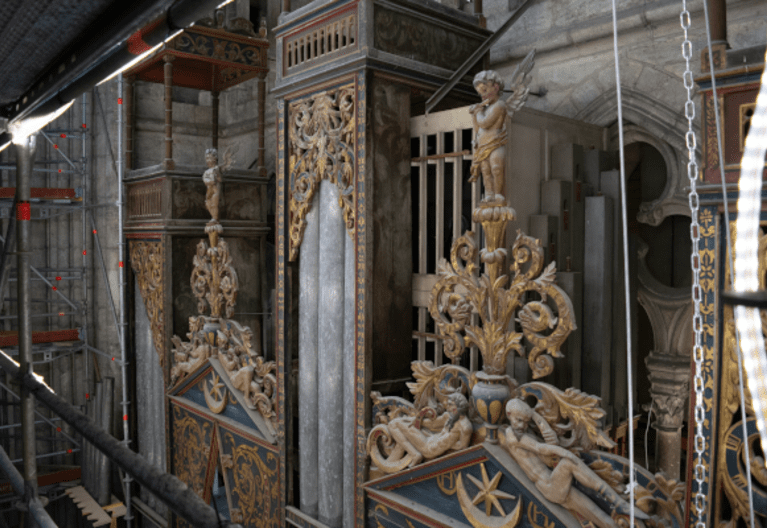Protecting movable objects as historical monuments
The protection of movable objects as historical monuments constitutes a public utility easement. There are two levels of protection for historic monuments: inscription and classification. In both cases, the protection must be justified by the interest of the movable object concerned from the point of view of history, art, science or technology. Registration is the first level of protection, and ranking the highest level.
- The balance sheet of protection
- The conditions of the protection
- The protection procedure
- The effects of protection
The balance sheet of protection
At 1er January 2022, more than 260,000 movable objects are protected as historic monuments, including more than 120,000 classified (since 1891) and nearly 140,000 inscribed (since 1970).
The annual protection report movable objects as historical monuments provides a state of protection in terms of statistics, typologies, dating, nature of owners.
The conditions of the protection
Protection under historic monuments may concern movable objects of all types (painting, sculpture, furniture, textiles, goldsmiths, musical instruments, industrial, scientific and technical heritage, etc.) and all time. Thus, the industrial, scientific and technical heritage takes an increasingly important place among the protected heritage, just like the heritage of the XIXe and XXe centuries.
The movable effects attached to perpetual remains (namely the movable objects which are, in the light of article 525 of the Civil Code, « plaster or lime or cement seals to a building, or, which cannot be detached from it without being fractured or deteriorated, or without breaking or deteriorating the part of the fund to which they are attached ") constitute buildings by destination and are protected as movable objects as historic monuments.
Thehistorical, artistic, scientific or technical interest of the movable object is the determining criterion for protection. The registration measure is decided at the regional level (decision of the regional prefect after the regional heritage and architecture commission) while the classification is decided at national level (decision of the Minister of Culture after notice of the National Heritage and Architecture Commission).
In view of these criteria and conditions, the heritage interest of a movable object is evaluated in particular according to its artistic or technical quality, its authenticity, its integrity, its rarity, its exemplarity, its representativeness in relation to a corpus or a type.
However, the protection of historic monuments is not intended to apply to the most recent movable objects created less than 50 years ago. Protection under historic monuments is, in principle, irreversible and requires sufficient historical hindsight.
A set or collection of movable objects of high heritage interest from the point of view of history, art, architecture, archaeology, ethnology, science, or technology, and whose preservation of integrity and coherence is of public interest, may be classified as historical monuments as furniture historical complex. These links may be historical, functional or aesthetic; the circumstances of creation or constitution of the movable historical ensemble, but also its state of integrity, must be documented so that it can be recognized as such.
In the case where there are particularly strong historical or artistic links between a classified movable object (or a historical set classified movable) and the classified building that houses it, a maintenance easement may be instituted, in order to ensure the conservation of the object or the whole in its original framework.
The protection procedure
The request for protection under historic monuments may come from the owner of the property, the assignee, or any person having an interest in it (territorial collectivity, heritage defence association, etc.). The initiative for protection can also come from the services of the prefect of the region (regional directorate of cultural affairs) or the Minister of Culture (general directorate of heritage and architecture).
Applications for the classification or inscription of movable objects as historic monuments must be addressed to the Prefect of the Region (Regional Directorate for Cultural Affairs). They must be accompanied by a description of the movable object, as well as photographs showing its interest from the point of view of history, art, science or technology, and, as far as possible, elements relating to its history and production.
Theregistration in respect of historic monuments is decided by order of the prefect of region, after notice of the regional commission heritage and architecture. The agreement of the owner is necessary for the inscription of private movable objects.
The ranking as historical monuments is decided by order of the Minister of Culture, after notice of the National Commission heritage and architecture, preceded by a wish of the regional commission of heritage and architecture, and in the light of the agreement of the owner. In the absence of agreement of the owner, the classification of a movable object can be pronounced by decree in the Council of State, but this procedure remains exceptional.
Where the conservation of a movable object of heritage interest, or its maintenance on national territory is threatened, a filing authority in respect of historic monuments may be taken by the Minister of Culture. This decision places the property under classification for twelve months, leaving time for the State services to examine the advisability of a final protection decision (registration or classification). This is an exceptional precautionary measure.
The classification as a historical set of furniture is decided by order of the Minister of Culture, in the light of the agreement of the owner, after the opinion of the National Heritage and Architecture Commission, preceded by a first level opinion of the Regional Heritage and Architecture Commission. If the owner does not agree, a historic set of furniture may be classified by decree in the Council of State. All the effects of the classification apply to each of the movable objects of the set.
A maintenance easement a listed movable object or a listed movable ensemble, in a listed immovable, is decided by order of the Minister of Culture, in the light of the agreement of the owner, after consulting the National Commission of Heritage and Architecture, preceded by a first-level opinion from the Regional Committee on Heritage and Architecture.
Application for protection under historic monuments
The effects of protection
The owner is responsible for the conservation of the movable object protected as a historical monument belonging to him.
In the event of a sale, the private owner of a movable object protected under historical monuments has the obligation to inform the new purchaser of the existence of the easement of classification or registration, and to inform the regional prefect thereof within fifteen days.
Classified movable property belonging to the State is inalienable. Classified movable objects belonging to a public person other than the State (territorial collectivity, public institution) may only be disposed of after authorization from the regional prefect and for the benefit of another public person. Movable objects classified or registered belonging to a public person, national treasures, are part of its movable public domain.
All classified movable objects are imprescriptible and definitive export bans.
Apart from the maintenance work without formalities, theclassified furniture in respect of historic monuments may not be worked without authorization issued by the prefect of region. Authorized work is performed under the scientific and technical control (CSE) the State services responsible for historic monuments, which are carried out from the beginning of the preparatory documentary and technical studies and throughout the works until their completion. The specifications of the planned intervention may be drawn up in conjunction with the State services in charge of historic monuments, which are notified of any study or intervention project on classified movable objects.
The State may demand any territorial collectivity failing to carry out the work that has become essential to ensure the conservation of a classified movable object, or request its interim transfer. In the event of inaction, the regional prefect may initiate an ex officio listing of the corresponding expenditure in the budget of the territorial collectivity in question in order to guarantee the restoration of the object whose conservation is compromised.
Apart from the maintenance work without formalities, theregistered movable object cannot be worked on without prior declaration. The work is carried out under their scientific and technical control (CST) which is carried out throughout the work until completion.
The movements of classified and registered movable objects are subject to a prior declarationeven without change of ownership or for a temporary loan or exhibition and, for public properties, under the scientific and technical control of the State services in charge of historic monuments. The movement of classified or registered movable objects belonging to private owners may take place, at their request, with the technical assistance of the State services in charge of historic monuments.
At least every five years, classified movable objects shall be recoloring (control of the presence and conditions of conservation) by the services in charge of historical monuments, in connection with the curators of antiques and works of art.




